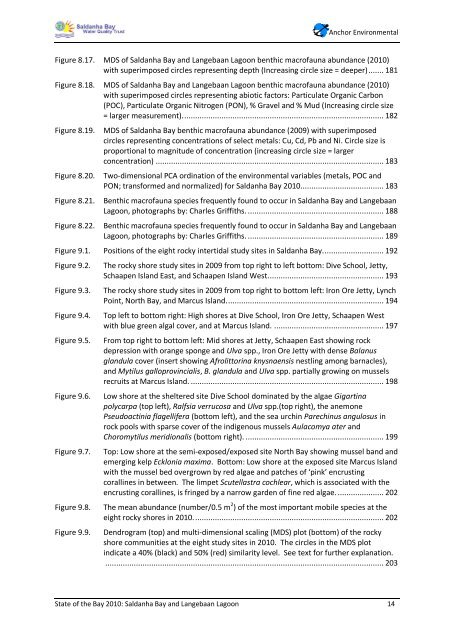State of the Bay Report 2010-Final - Anchor Environmental
State of the Bay Report 2010-Final - Anchor Environmental
State of the Bay Report 2010-Final - Anchor Environmental
You also want an ePaper? Increase the reach of your titles
YUMPU automatically turns print PDFs into web optimized ePapers that Google loves.
<strong>Anchor</strong> <strong>Environmental</strong><br />
Figure 8.17. MDS <strong>of</strong> Saldanha <strong>Bay</strong> and Langebaan Lagoon benthic macr<strong>of</strong>auna abundance (<strong>2010</strong>)<br />
with superimposed circles representing depth (Increasing circle size = deeper) ....... 181<br />
Figure 8.18. MDS <strong>of</strong> Saldanha <strong>Bay</strong> and Langebaan Lagoon benthic macr<strong>of</strong>auna abundance (<strong>2010</strong>)<br />
with superimposed circles representing abiotic factors: Particulate Organic Carbon<br />
(POC), Particulate Organic Nitrogen (PON), % Gravel and % Mud (Increasing circle size<br />
= larger measurement). ........................................................................................... 182<br />
Figure 8.19. MDS <strong>of</strong> Saldanha <strong>Bay</strong> benthic macr<strong>of</strong>auna abundance (2009) with superimposed<br />
circles representing concentrations <strong>of</strong> select metals: Cu, Cd, Pb and Ni. Circle size is<br />
proportional to magnitude <strong>of</strong> concentration (increasing circle size = larger<br />
concentration) ........................................................................................................ 183<br />
Figure 8.20. Two-dimensional PCA ordination <strong>of</strong> <strong>the</strong> environmental variables (metals, POC and<br />
PON; transformed and normalized) for Saldanha <strong>Bay</strong> <strong>2010</strong>...................................... 183<br />
Figure 8.21. Benthic macr<strong>of</strong>auna species frequently found to occur in Saldanha <strong>Bay</strong> and Langebaan<br />
Lagoon, photographs by: Charles Griffiths. .............................................................. 188<br />
Figure 8.22. Benthic macr<strong>of</strong>auna species frequently found to occur in Saldanha <strong>Bay</strong> and Langebaan<br />
Lagoon, photographs by: Charles Griffiths. .............................................................. 189<br />
Figure 9.1. Positions <strong>of</strong> <strong>the</strong> eight rocky intertidal study sites in Saldanha <strong>Bay</strong>. ........................... 192<br />
Figure 9.2. The rocky shore study sites in 2009 from top right to left bottom: Dive School, Jetty,<br />
Schaapen Island East, and Schaapen Island West. .................................................... 193<br />
Figure 9.3. The rocky shore study sites in 2009 from top right to bottom left: Iron Ore Jetty, Lynch<br />
Point, North <strong>Bay</strong>, and Marcus Island. ....................................................................... 194<br />
Figure 9.4. Top left to bottom right: High shores at Dive School, Iron Ore Jetty, Schaapen West<br />
with blue green algal cover, and at Marcus Island. .................................................. 197<br />
Figure 9.5. From top right to bottom left: Mid shores at Jetty, Schaapen East showing rock<br />
depression with orange sponge and Ulva spp., Iron Ore Jetty with dense Balanus<br />
glandula cover (insert showing Afrolittorina knysnaensis nestling among barnacles),<br />
and Mytilus galloprovincialis, B. glandula and Ulva spp. partially growing on mussels<br />
recruits at Marcus Island. ........................................................................................ 198<br />
Figure 9.6. Low shore at <strong>the</strong> sheltered site Dive School dominated by <strong>the</strong> algae Gigartina<br />
polycarpa (top left), Ralfsia verrucosa and Ulva spp.(top right), <strong>the</strong> anemone<br />
Pseudoactinia flagellifera (bottom left), and <strong>the</strong> sea urchin Parechinus angulosus in<br />
rock pools with sparse cover <strong>of</strong> <strong>the</strong> indigenous mussels Aulacomya ater and<br />
Choromytilus meridionalis (bottom right). ............................................................... 199<br />
Figure 9.7. Top: Low shore at <strong>the</strong> semi-exposed/exposed site North <strong>Bay</strong> showing mussel band and<br />
emerging kelp Ecklonia maxima. Bottom: Low shore at <strong>the</strong> exposed site Marcus Island<br />
with <strong>the</strong> mussel bed overgrown by red algae and patches <strong>of</strong> ‘pink’ encrusting<br />
corallines in between. The limpet Scutellastra cochlear, which is associated with <strong>the</strong><br />
encrusting corallines, is fringed by a narrow garden <strong>of</strong> fine red algae. ..................... 202<br />
Figure 9.8. The mean abundance (number/0.5 m 2 ) <strong>of</strong> <strong>the</strong> most important mobile species at <strong>the</strong><br />
eight rocky shores in <strong>2010</strong>. ...................................................................................... 202<br />
Figure 9.9. Dendrogram (top) and multi-dimensional scaling (MDS) plot (bottom) <strong>of</strong> <strong>the</strong> rocky<br />
shore communities at <strong>the</strong> eight study sites in <strong>2010</strong>. The circles in <strong>the</strong> MDS plot<br />
indicate a 40% (black) and 50% (red) similarity level. See text for fur<strong>the</strong>r explanation.<br />
............................................................................................................................... 203<br />
<strong>State</strong> <strong>of</strong> <strong>the</strong> <strong>Bay</strong> <strong>2010</strong>: Saldanha <strong>Bay</strong> and Langebaan Lagoon 14

















